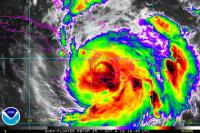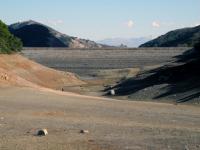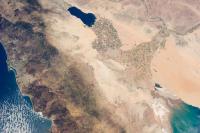-
When catastrophe strikes, who foots the bill?
One consequence of climate change is that extreme weather events are occurring more often with the potential to cause catastrophic damage more frequently. According to the 2016 Global Risks Report of the World Economic Forum, extreme weather events rank second as the most likely threat to global stability going forward. And my research on the safety and soundness of financial institutions suggests this trend may also threaten the stability of the insurance industry. Extreme weather is expensive for insurance companies and their reinsurers, communities, taxpayers, and also, potentially, capital market investors. And it’s only getting more expensive as climate change increases the frequency of storms and their severity. While more can be done to improve risk pricing and risk management, climate change mitigation is critical for our ability to continue to survive and recover from the catastrophes that lie ahead.
-
-
As the climate warms, New Jersey “primed” for worse storms than Sandy
With the climate warming and the sea level rising, conditions are ripe for storms deadlier and more devastating than Sandy that put more people at risk. Experts say that Sandy was not the worst possible storm in the region and they warn that as the sea rises, much weaker storms than Sandy may pack big punches. The atmosphere will hold nearly 4 percent more moisture for every 1 degree Fahrenheit rise in temperature, and the increased warmth and moisture will lead to a more energetic atmosphere.
-
-
S&T, NASA show online tool to help prepare for solar storms
When solar storms release solar flares and coronal mass ejections (CME) toward Earth, we can feel the effects here on the ground. They can interfere with Earth’s magnetic field and produce geo-magnetically induced currents. These currents impact our electric grid and can cause permanent damage to critical grid components, including high-voltage transformers. While we cannot stop solar storms and CMEs, we can mitigate their effect on the electric grid.
-
-
A military view on climate change: It’s eroding our national security and we should prepare for it
U.S. military leaders and defense planners have been studying climate change for years from a perspective that rarely is mentioned in the news: as a national security threat. And they agree that it poses serious risks. Here is how military planners see this issue: We know that the climate is changing, we know why it’s changing, and we understand that change will have large impacts on our national security. Yet as a nation we still only begrudgingly take precautions. The next president will have a choice to make. One option is to continue down the path that the Obama administration has defined and develop policies, budgets, plans, and programs that flesh out the institutional framework now in place. Alternatively, he or she can call climate change a hoax manufactured by foreign governments and ignore the flashing red lights of increasing risk. The world’s ice caps will not care who is elected or what is said. They will simply continue to melt, as dictated by laws of physics. But Americans will care deeply about our policy response. Our nation’s security is at stake.
-
-
New $4 million facility at UW to investigate natural disasters worldwide
A new Post-Disaster, Rapid Response Research Facility at the University of Washington will provide necessary instrumentation and tools to collect and assess critical post-disaster data, with the goal of reducing physical damage and socio-economic losses from future events. The NSF’s $40 million NHERI investment, announced in September 2015, funds a network of shared research centers and resources at various universities across the nation. The goal is to reduce the vulnerability of buildings, tunnels, waterways, communication networks, energy systems, and social groups in order to increase the disaster resilience of communities across the United States.
-
-
Strengthening U.S. infrastructure to withstand disasters
The delivery of essential services — whether in food, water, health, or emergency response — relies increasingly upon a complex, interconnected system of critical infrastructure. Ensuring these interdependent systems continue to operate during disasters and other disruptive events is crucial to maintaining public health and safety. NSF announces $22.7 million in new investments to promote better understanding and functioning of these infrastructures in an effort to improve their resilience.
-
-
Hurricane Matthew’s losses could reach $15 billion

As Hurricane Matthew approaches Florida and the Carolinas, experts estimate that the losses may be as high as $15 billion. They warned that winds, heavy rain, and a storm surge could kill, wash out roads, cut communication links, and cause outages lasting weeks. Twelve U.S. power generators, including two nuclear plants, are in the storm’s path. One nuclear facility, NextEra Energy Inc.’s Turkey Point in south Florida, is located just outside of the storm’s track.
-
-
FCC updates, strengthens Wireless Emergency Alerts (WEA)
The Federal Communications Commission (FCC) two weeks ago adopted rules to update and strengthen Wireless Emergency Alerts (WEA), a system that delivers critical warnings and information to Americans on their wireless phones. The updated rules are intended to promote the wider use and effectiveness of this lifesaving service, especially for state and local authorities to convey important information to their communities.
-
-
Megadrought lasting three decades likely for Southwest U.S., Midwest

The consequences of climate change paint a bleak picture for the Southwest and much of America’s breadbasket, the Great Plains. The role of climate change in causing extreme heat waves, drastic rainfall, negative impacts on human health, and threatened food security have received more attention recently than megadrought, but scientists view prolonged drought risk as yet another natural hazard that becomes more likely from human activity.
-
-
Relentless rise of CO2 passes troubling milestone, locking in a warmer future
Carbon dioxide levels in Earth’s atmosphere passed a troubling milestone for good this summer and locked in levels of the heat-trapping gas not seen for millions of years. Every year, the amount of carbon dioxide (CO2) rises during winter and then falls slightly during the Northern Hemisphere’s growing season, as plants take up the greenhouse gas during photosynthesis. But this year, for the first time since before the Ice Age, CO2 will not fall below 400 ppm.
-
-
$3 million grant to build terrorism, disaster resilience
LSU Health New Orleans School of Medicine’s Department of Psychiatry has been awarded a $3 million grant over five to build the Terrorism and Disaster Coalition for Child and Family Resilience, with a focus on terrorism and disasters. The purpose of the Coalition is to create effective partnerships in disaster-prone regions to enhance national capacity to prepare and respond to the unique needs of children, adolescents, and families after disasters and terrorism.
-
-
New fault discovered in earthquake-prone southern California

A swarm of nearly 200 small earthquakes that shook Southern California residents in the Salton Sea area last week raised concerns they might trigger a larger earthquake on the southern San Andreas Fault. Scientists have discovered a potentially significant fault that lies along the eastern edge of the Salton Sea. The presence of the newly mapped Salton Trough Fault, which runs parallel to the San Andreas Fault, could impact current seismic hazard models in the earthquake-prone region that includes the greater Los Angeles area. Mapping of earthquake faults provides important information for earthquake rupture and ground-shaking models, which helps protect lives and reduce property loss from these natural hazards.
-
-
Global warming could hit 2°C threshold by 2050
Without additional action and advanced technologies, global emissions are expected to be 33 percent above the 2°C pathway in 2030, according to a new report. The 2°C target was formally agreed upon at the Paris climate talks in 2015, as an international target to avoid the worst effects of climate change.
-
-
Optimal strategies to cope with climate change depend on the pace of change
What would we do differently if sea level were to rise one foot per century versus one foot per decade? Until now, most policy and research has focused on adapting to specific amounts of climate change and not on how fast that climate change might happen. Researchers, using sea-level rise as a case study, have developed a quantitative model that considers different rates of sea-level rise, in addition to economic factors, and shows how consideration of rates of change affect optimal adaptation strategies.
-
-
High-tech early warning system for hurricanes, tornados, and volcanic eruptions
Earlier this year, the Laser Interferometer Gravitational-Wave Observatory (LIGO) was able to detect a gravity wave wafting through space from two colliding black holes billions of years ago. Now a group of researchers has built a much smaller ring laser interferometer to explore how it could detect geophysical effects such as earthquake-generated ground rotation and infrasound from convective storms and have demonstrated the technology’s potential as an early-warning system for natural disasters.
-
More headlines
The long view
Using Drone Swarms to Fight Forest Fires
Forest fires are becoming increasingly catastrophic across the world, accelerated by climate change. Researchers are using multiple swarms of drones to tackle natural disasters like forest fires.
How Climate Change Will Affect Conflict and U.S. Military Operations
“People talk about climate change as a threat multiplier,” said Karen Sudkamp, an associate director of the Infrastructure, Immigration, and Security Operations Program within the RAND Homeland Security Research Division. “But at what point do we need to start talking about the threat multiplier actually becoming a significant threat all its own?”
